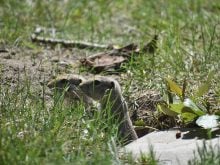A group opposed to GM crops is accusing Canadian regulators of rubber-stamping the latest stacked trait offering from Monsanto and Dow AgroSciences, but a Canadian Food Inspection Agency official says the accusations are false.
The Canadian Biotechnology Action Network said the CFIA failed to produce a decision document summarizing the approval decision for SmartStax corn, a crop containing eight traits protecting it against insect and weed infestations.
“You’d think that a combination of eight (GM) traits would trigger an environmental assessment but the CFIA has no public record of their evaluation,” said Lucy Sharratt, co-ordinator of the network.
Read Also

Rural officials hopeful strychnine use will resume
The Saskatchewan Association of Rural Municipalities is taking a verbal commitment from the federal agriculture minister on strychnine use as a good sign.
“This seems to confirm that the corn bypassed existing scientific assessment processes that have already been judged insufficient by the 2001 Royal Society of Canada Panel.”
Krista Thomas, acting national manager of the CFIA’s plant biosafety office, said decision documents are not required for plants created by cross-breeding previously approved GM crops.
The regulator has approved about 20 such stacked trait plants since 2003.
The agency is only required to post a notification of its approval, which it did on its website, including links to the decision documents on the previously approved traits.
Thomas said SmartStax corn has been fully approved for food, feed and environmental release.
“The CFIA is absolutely not lowering its standards for the safety of new Bt corn lines,” she said.
The new corn variety allows producers to reduce the amount of refuge area they have to set aside in order to limit the likelihood of insect resistance to the Bt corn. The new refuge requirement is five percent, down from 20.
“Not only has CFIA failed to evaluate the environmental risks of this new (GM) corn, it has also dramatically reduced one of its only environmental requirements in the field,” said Sharratt.
Thomas said the agency conducted a thorough review of the scientific data and concluded the five percent refuge would be equally or more effective at delaying the development of resistance in insect pests with SmartStax corn as the 20 percent refuge was with earlier GM corn varieties.
The decision to cut the refuge area will be reviewed in 2013. Eric Darier, agriculture campaigner for Greenpeace Canada, said that review will be based on data supplied by Monsanto and Dow.
Thomas said the review will also include information provided by independent audits of on-farm compliance and consultation with university researchers, producer organizations and government officials.















